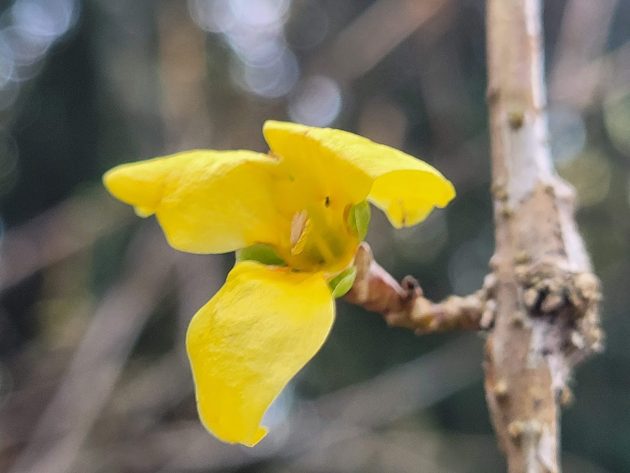
This blossom on an otherwise bare Albany forsythia bush suggests that spring is getting close.
Even though the start of spring is still three weeks away, the sight of a lone yellow blossom Wednesday was a hopeful sign of milder weather.
Why hopeful? Because our heating bills in the mid-valley should now begin their seasonal decline.
The bills that Pacific Power and Northwest Natural sent this month showed an interesting fact. According to the utilities, the period represented by those bills this year was substantially colder than the same period of the year before.
One Albany power bill said the average daily temperature was 39 degrees this year, which was 4 degrees colder than in the comparable billing period that ended in February 2024.
The natural gas bill showed an even greater cooling: 9 degrees colder this year than in 2024, which probably explains why natural gas consumption was 40 percent higher. (That, and the more frequent use of the gas fireplace, probably.)
Utility bills are but one indicator of changing temperatures. A more precise one can be found here, the website of the Oregon Climate Service at Oregon State University. The site records lots of weather-related data, including the daily readings of lows and highs at the Hyslop Weather Station.
The station is off Highway 20 near Granger Avenue, between Albany and Corvallis.
At Hyslop, the average high in January was 47 degrees F, exactly the same as the 20-year average for the month. But the mean low in January was 30.7, which was 3.3 degrees colder than the long-term average.
You can scan the Hyslop readings over the years. For all of 2024, for instance, the mean monthly high temperature was warmer than average for every month except March, when it was half a degree cooler. But in five months of the year, the nighttime lows were colder than average.
I don’t know if looking up the highs and lows and comparing them to the 20-year average shows anything. But it does show what we already know, that the weather changes a little from year to year.
Which is what that little yellow blossom, three weeks before the start of spring, tells us too. (hh)


The scientific consensus is settled. The weather does change a little from year to year.
But in 2009 former Vice President Al Gore said the scientific consensus was the North Pole would be ice-free by summer 2013.
Upon further reflection, maybe we should take all claims of scientific consensus with a pinch of salt.
… and Gore’s statement was immediately challenged by the scientific community:
https://www.npr.org/sections/thetwo-way/2009/12/al_gore_trips_on_artic_ice_mis.html
So what about all this Gordon? Are you claiming the scientific community WAS Al Gore?
Pretty silly on your part.
Looking forward to spring. Our Daphne bush has had blooms for weeks. Also many crocus and daffodils showing their flowers.
Come on, Hasso. Stop dancing around the edges of your anti-climate change adjacency. Just come out in full climate change denial. Admit to your skepticism. Fear not the slings and arrows of the Globalistas and the Climate Deep State. The Orange King will protect you until he won’t.
Hasso won’t do this. He’s too mealy-mouthed.